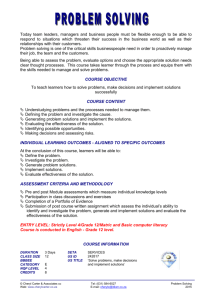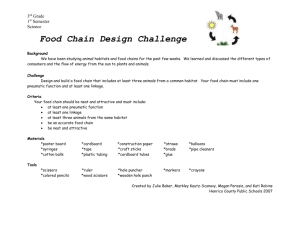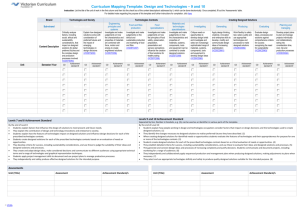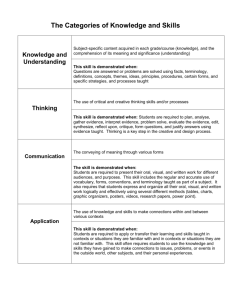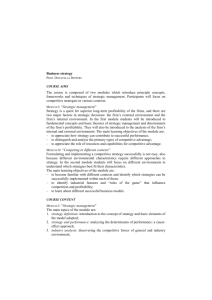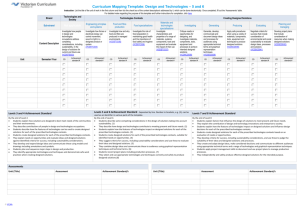Course Aims and Structure
advertisement
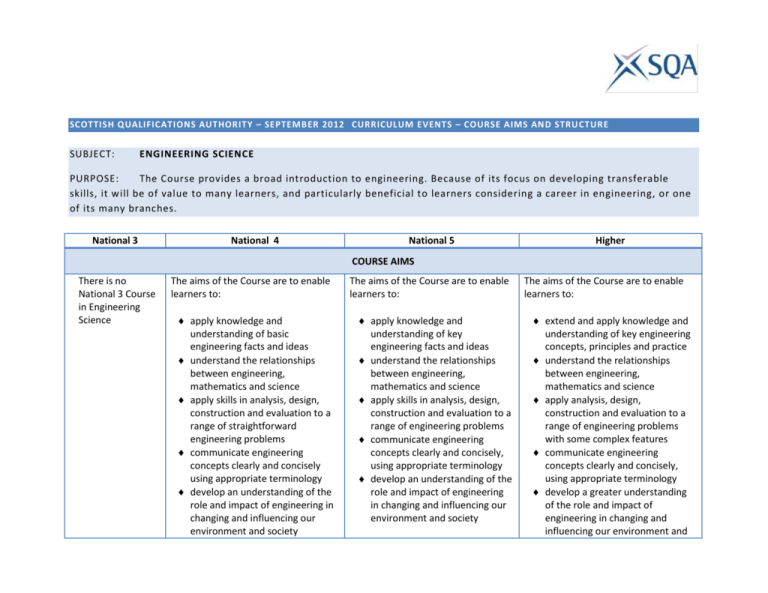
SCOTTISH QUALIFICATIONS AUTHORITY – SEPTEMBER 2012 CURRICULUM EVENTS – COURSE AIMS AND STRU CTURE SUBJECT: ENGINEERING SCIENCE PURPOSE: The Course provides a broad introduction to engineering. Because of its focus on developing transferable skills, it will be of value to many learners, and particularly beneficial to learners considering a career in engineering, or one of its many branches. National 3 National 4 National 5 Higher COURSE AIMS There is no National 3 Course in Engineering Science The aims of the Course are to enable learners to: apply knowledge and understanding of basic engineering facts and ideas understand the relationships between engineering, mathematics and science apply skills in analysis, design, construction and evaluation to a range of straightforward engineering problems communicate engineering concepts clearly and concisely using appropriate terminology develop an understanding of the role and impact of engineering in changing and influencing our environment and society The aims of the Course are to enable learners to: apply knowledge and understanding of key engineering facts and ideas understand the relationships between engineering, mathematics and science apply skills in analysis, design, construction and evaluation to a range of engineering problems communicate engineering concepts clearly and concisely, using appropriate terminology develop an understanding of the role and impact of engineering in changing and influencing our environment and society The aims of the Course are to enable learners to: extend and apply knowledge and understanding of key engineering concepts, principles and practice understand the relationships between engineering, mathematics and science apply analysis, design, construction and evaluation to a range of engineering problems with some complex features communicate engineering concepts clearly and concisely, using appropriate terminology develop a greater understanding of the role and impact of engineering in changing and influencing our environment and National 3 National 4 National 5 Higher society STRUCTURE, ASSESSMENT AND HIERARCHIES Course Structure: Units and Added Value Unit Course Structure: Units and Course Assessment Engineering Contexts and Challenges 1) Investigate simple engineered objects 2) Investigate engineering challenges and relate these to key engineering facts and ideas 3) Describe, in simple terms, some aspects of the benefits of engineering Engineering Contexts and Challenges 1) Investigate engineered objects 2) Investigate engineering challenges and relate these to key engineering concepts 3) Describe some aspects of the impact of engineering Electronics and Control 1) Develop simple analogue electronic control systems 2) Develop simple digital electronic control systems Mechanisms and Structures 1) Investigate a range of simple mechanical and pneumatic systems 2) Develop mechanical or pneumatic solutions to solve straightforward problems Electronics and Control 1) Develop analogue electronic control systems 2) Develop digital electronic control systems Mechanisms and Structures 1) Investigate a range of mechanical and pneumatic systems 2) Develop mechanical or pneumatic solutions to solve problems Course Structure: Units and Course Assessment Engineering Contexts and Challenges 1) Research and describe a complex engineering system 2) Model aspects of a complex engineered solution 3) Present a critical analysis of an engineered solution to a contemporary problem Electronics and Control 1) Develop analogue electronic control systems 2) Develop digital electronic control systems 3) Develop programmable control systems for mechatronic systems Mechanisms and Structures 1) Investigate a range of complex mechanisms and structures 2) Develop mechanical or structural solutions to solve complex problems National 3 National 4 Added Value Unit Engineering Science Assignment 1) Develop, with guidance, an engineering solution which will draw on and apply skills and knowledge of mechanisms, structures and electronic control systems Hierarchies: Each Unit is hierarchical with corresponding Unit at National 5. National 5 Higher Course Assessment Question Paper Assignment Course Assessment Question Paper Assignment Hierarchies: Each Unit is hierarchical with corresponding Unit at National 4 and Higher. Hierarchies: Each Unit is hierarchical with corresponding Unit at National 5. SKILLS, KNOWLEDGE AND UNDERSTANDING analysing, with guidance, straightforward engineering problems designing, developing, simulating, building and testing, with guidance, solutions to straightforward engineering problems in a range of contexts investigating, with guidance, some existing and emerging technologies communicating basic engineering facts and ideas clearly and concisely using appropriate terminology awareness of the main branches of analysing engineering problems designing, developing, simulating, building, testing and evaluating solutions to engineering problems in a range of contexts investigating and evaluating existing and emerging technologies communicating engineering concepts clearly and concisely, using appropriate terminology knowledge of the many types of engineering knowledge of the wide role and impact of engineering on society and the environment analysing engineering problems with some complex features designing, developing, simulating, building, testing and evaluating solutions to engineering problems in a range of contexts investigating and evaluating existing and emerging technologies communicating engineering concepts clearly and concisely, using appropriate terminology knowledge and understanding of the many types of engineering knowledge and understanding of the wide role and impact of engineering on society and the National 3 National 4 engineering: electrical, mechanical, civil and chemical basic knowledge of the wide role and impact of engineering on society and the environment basic knowledge of the workings of a range of simple engineered objects knowledge of key facts and ideas related to electronic and microcontroller-based control systems, and their application knowledge of key facts and ideas related to mechanical, structural and pneumatic systems, and their application basic knowledge of the relevance of energy, efficiency and sustainability to straightforward engineering problems and solutions applying engineering knowledge and skills in a range of straightforward contexts National 5 knowledge of the workings of a range of engineered objects knowledge and understanding of key concepts related to electronic and microcontroller-based systems, and their application knowledge and understanding of key concepts related to mechanical, structural and pneumatic systems, and their application knowledge of the relevance of energy, efficiency and sustainability to engineering problems and solutions applying engineering knowledge and skills in a range of contexts Higher environment knowledge and understanding of the workings of a range of engineered objects knowledge and understanding of key concepts related to electronic and microcontroller-based systems, and their application knowledge and understanding of key concepts related to mechanical, structural and pneumatic systems, and their application knowledge and understanding of the relevance of energy, efficiency and sustainability to engineering problems and solutions applying engineering knowledge, understanding and skills in a range of contexts
